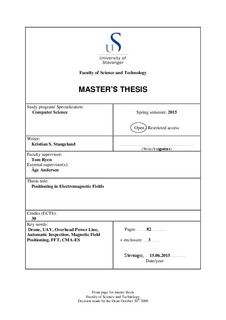| dc.contributor.author | Stangeland, Kristian | |
| dc.date.accessioned | 2015-09-09T10:51:38Z | |
| dc.date.available | 2015-09-09T10:51:38Z | |
| dc.date.issued | 2015-06-15 | |
| dc.identifier.uri | http://hdl.handle.net/11250/299170 | |
| dc.description | Master's thesis in Computer science | nb_NO |
| dc.description.abstract | Drones (or Unmanned Aerial Vehicles) can become an important tool for performing the
regular inspection of overhead power lines in difficult terrain. This currently requires a
pilot, but if we could detect the position of the power line using magnetic field sensors,
we might be able to automatically navigate alongside it. This would also be useful in
remotely measuring the amount of current flowing through the conductors.
We then focus on the magnetic field around a three-phase single-circuit power line.
Using either a mathematical model, or a FFT (Fast-Fourier Transform) of 8 samples
of the field, we compute two values per component that are invariant to the unknown
current, but depend on the location of the drone. Using CMA-ES (Covariance Matrix
Adaptation Evolution Strategy), we estimate the corresponding point given at least two
sensors and four invariants per sensor. As suggested by experimental data, we also
consider the possibility that each conductor is carrying a different amount of current.
Using this approach, we successfully navigate a simulated drone using three magnetic
field sensors, where two is the minimum. The estimated position is accurate down to
about 1.8mm, needing about 350ms of computational time on a desktop computer.
This enables us to position a drone with better accuracy than using a GPS alone.
We can also use this method to cancel drift in an INS (Inertial Navigation System). | nb_NO |
| dc.language.iso | eng | nb_NO |
| dc.publisher | University of Stavanger, Norway | nb_NO |
| dc.relation.ispartofseries | Masteroppgave/UIS-TN-IDE/2015; | |
| dc.subject | informasjonsteknologi | nb_NO |
| dc.subject | signalbehandling | nb_NO |
| dc.subject | datateknikk | nb_NO |
| dc.subject | droner | nb_NO |
| dc.subject | magnetic field positioning | nb_NO |
| dc.title | Positioning in electromagnetic fields | nb_NO |
| dc.type | Master thesis | nb_NO |
| dc.subject.nsi | VDP::Technology: 500::Information and communication technology: 550::Computer technology: 551 | nb_NO |
